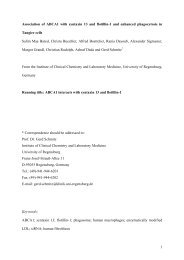SUNDAY, DECEMBER 4- Late Abstracts 1 - Molecular Biology of the ...
SUNDAY, DECEMBER 4- Late Abstracts 1 - Molecular Biology of the ...
SUNDAY, DECEMBER 4- Late Abstracts 1 - Molecular Biology of the ...
You also want an ePaper? Increase the reach of your titles
YUMPU automatically turns print PDFs into web optimized ePapers that Google loves.
<strong>SUNDAY</strong><br />
protein may play a critical role in maintaining neuronal homeostasis by regulating endosomal<br />
trafficking and mitochondrial transport. Fur<strong>the</strong>r characterization <strong>of</strong> <strong>the</strong> mechanisms <strong>of</strong> Trak1<br />
action and its regulation will provide a better understanding <strong>of</strong> <strong>the</strong> role <strong>of</strong> Trak1 in hypertonia<br />
and epilepsy.<br />
1979<br />
Post-Fusion Actin Coating <strong>of</strong> Secretory Vesicles is required for Active Content Extrusion<br />
in Alveolar Type II Cells.<br />
P. Miklavc 1 , E. Hecht 1 , N. Hobi 2 , O. H. Wittekindt 1 , T. Haller 2 , P. Dietl 1 , E. Felder 1 , C. Kranz 1 , M.<br />
Frick 1 ; 1 University <strong>of</strong> Ulm, Ulm, Germany, 2 Innsbruck Medical University, Innsbruck, Austria<br />
Exocytosis <strong>of</strong> secretory vesicles is a fundamental cellular process allowing regulated secretion<br />
<strong>of</strong> vesicle contents in <strong>the</strong> extracellular space. Growing evidence suggests that regulation <strong>of</strong><br />
fusion pore dilation during <strong>the</strong> post-fusion stage <strong>of</strong> exocytosis plays an important role in release<br />
<strong>of</strong> secretory vesicle contents. However, dependent on <strong>the</strong> nature <strong>of</strong> <strong>the</strong> cargo additional<br />
mechanisms might be essential to facilitate effective release. We have recently described in<br />
alveolar type II cells that surfactant-storing secretory vesicles (lamellar bodies) are coated with<br />
actin following fusion with <strong>the</strong> plasma membrane. Surfactant, a lipoprotein-like substance, does<br />
not readily diffuse out <strong>of</strong> fused lamellar bodies following opening and dilation <strong>of</strong> <strong>the</strong> fusion pore.<br />
Using fluorescence microscopy, atomic force microscopy and biochemical assays we present<br />
evidence that actin coating and subsequent compression <strong>of</strong> <strong>the</strong> actin coat is essential to<br />
facilitate surfactant secretion. Simultaneous imaging <strong>of</strong> <strong>the</strong> vesicle membrane and <strong>the</strong> actin coat<br />
revealed that contraction <strong>of</strong> <strong>the</strong> actin coat compresses <strong>the</strong> vesicle following fusion. This leads to<br />
active extrusion <strong>of</strong> vesicle contents. Preventing actin coating <strong>of</strong> fused LBs with latrunculin A<br />
inhibits surfactant secretion almost completely. Subsequent compression <strong>of</strong> <strong>the</strong> actin coat is<br />
modulated by myosin II. In summary our data suggest that fusion pore opening and dilation is<br />
not sufficient for “passive” release <strong>of</strong> bulky vesicle cargo in alveolar type II cells and that active<br />
extrusion mechanisms are required.<br />
1980<br />
Synaptotagmin-7 - <strong>the</strong> link between fusion-activated Ca 2+ -entry and regulation <strong>of</strong> fusion<br />
pore expansion?<br />
N. Sharma 1 , P. Miklavc 1 , K. Thompson 1 , O. H. Wittekindt 1 , E. Felder 1 , P. Dietl 1 , M. Frick 1 ;<br />
1 Institute <strong>of</strong> General Physiology, University <strong>of</strong> Ulm, Ulm, Germany<br />
Ca 2+ is <strong>the</strong> key element in regulated exocytosis controlling multiple steps during <strong>the</strong> exocytic<br />
pre- and post-fusion stages. We have recently described a “fusion-activated” Ca 2+ -entry (FACE)<br />
via vesicular P2X4 receptors during <strong>the</strong> post-fusion stage <strong>of</strong> lamellar body exocytosis in alveolar<br />
type II (ATII) cells. FACE regulates fusion pore expansion and vesicle content release during<br />
<strong>the</strong> post-fusion phase <strong>of</strong> exocytosis (PNAS, 2011 Aug 30;108(35):14503-8). Yet, <strong>the</strong> question<br />
remained how this locally restricted Ca 2+ signal is translated into mechanical force promoting<br />
fusion pore expansion. In this study we tested whe<strong>the</strong>r synaptotagmins could form a molecular<br />
link between FACE and fusion pore expansion. Members <strong>of</strong> <strong>the</strong> synaptotagmin family that<br />
localize to secretory vesicles have been found to promote fusion pore expansion via Ca 2+<br />
binding to C2 domains. Using RT-PCR and western-blotting we identified synaptotagmin-7 as<br />
<strong>the</strong> Ca 2+ -binding is<strong>of</strong>orm predominantly expressed in primary ATII cells. Immun<strong>of</strong>luorescence<br />
confirmed for <strong>the</strong> first time that synaptotagmin-7 is localised on lamellar bodies. We next<br />
performed functional studies over-expressing wt synaptotagmin-7 or mutants abolishing Ca 2+ -<br />
binding to ei<strong>the</strong>r <strong>the</strong> C2A, C2B or C2A and C2B domains. We measured diffusion rates <strong>of</strong><br />
fluorescent dyes through <strong>the</strong> fusion pore to directly assess dynamic changes in fusion pore<br />
diameters. Our results show that overexpression <strong>of</strong> nei<strong>the</strong>r wt nor mutant synaptotagmin-7
















